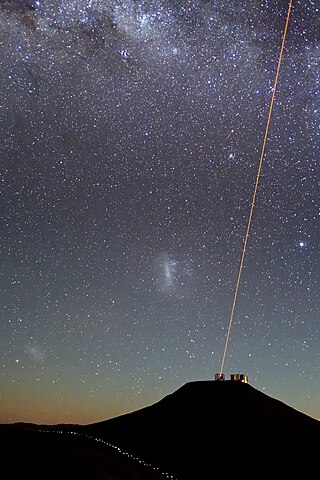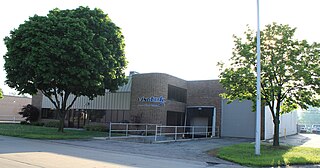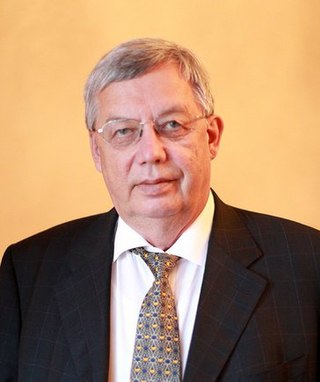
A laser is a device that emits light through a process of optical amplification based on the stimulated emission of electromagnetic radiation. The word laser is an anacronym that originated as an acronym for light amplification by stimulated emission of radiation. The first laser was built in 1960 by Theodore Maiman at Hughes Research Laboratories, based on theoretical work by Charles H. Townes and Arthur Leonard Schawlow.

An optical amplifier is a device that amplifies an optical signal directly, without the need to first convert it to an electrical signal. An optical amplifier may be thought of as a laser without an optical cavity, or one in which feedback from the cavity is suppressed. Optical amplifiers are important in optical communication and laser physics. They are used as optical repeaters in the long distance fiber-optic cables which carry much of the world's telecommunication links.

A laser diode is a semiconductor device similar to a light-emitting diode in which a diode pumped directly with electrical current can create lasing conditions at the diode's junction.

Photonics is a branch of optics that involves the application of generation, detection, and manipulation of light in the form of photons through emission, transmission, modulation, signal processing, switching, amplification, and sensing. Photonics is closely related to quantum electronics, where quantum electronics deals with the theoretical part of it while photonics deal with its engineering applications. Though covering all light's technical applications over the whole spectrum, most photonic applications are in the range of visible and near-infrared light. The term photonics developed as an outgrowth of the first practical semiconductor light emitters invented in the early 1960s and optical fibers developed in the 1970s.

The vertical-cavity surface-emitting laser is a type of semiconductor laser diode with laser beam emission perpendicular from the top surface, contrary to conventional edge-emitting semiconductor lasers which emit from surfaces formed by cleaving the individual chip out of a wafer. VCSELs are used in various laser products, including computer mice, fiber-optic communications, laser printers, Face ID, and smartglasses.
Optical networking is a means of communication that uses signals encoded in light to transmit information in various types of telecommunications networks. These include limited range local-area networks (LAN) or wide area networks (WANs), which cross metropolitan and regional areas as well as long-distance national, international and transoceanic networks. It is a form of optical communication that relies on optical amplifiers, lasers or LEDs and wavelength-division multiplexing (WDM) to transmit large quantities of data, generally across fiber-optic cables. Because it is capable of achieving extremely high bandwidth, it is an enabling technology for the Internet and telecommunication networks that transmit the vast majority of all human and machine-to-machine information.

Jenoptik AG is a Jena, Germany-based integrated photonics company. The company is listed on the Frankfurt Stock Exchange and is included in the TecDAX stock index.
A fiber laser is a laser in which the active gain medium is an optical fiber doped with rare-earth elements such as erbium, ytterbium, neodymium, dysprosium, praseodymium, thulium and holmium. They are related to doped fiber amplifiers, which provide light amplification without lasing.

Fiber-optic communication is a method of transmitting information from one place to another by sending pulses of infrared or visible light through an optical fiber. The light is a form of carrier wave that is modulated to carry information. Fiber is preferred over electrical cabling when high bandwidth, long distance, or immunity to electromagnetic interference is required. This type of communication can transmit voice, video, and telemetry through local area networks or across long distances.
Power scaling of a laser is increasing its output power without changing the geometry, shape, or principle of operation. Power scalability is considered an important advantage in a laser design. This means it can increase power without changing outside features.
A fiber disk laser is a fiber laser with transverse delivery of the pump light. They are characterized by the pump beam not being parallel to the active core of the optical fiber, but directed to the coil of the fiber at an angle. This allows use of the specific shape of the pump beam emitted by the laser diode, providing the efficient use of the pump.
EKSPLA is a laser and laser electronics manufacturing company based in Vilnius, Lithuania. EKSPLA is known for their lasers and laser systems, as well as other photonics components. The company is supplying their products for scientific, OEM and industrial applications.

The Ferdinand-Braun-Institut, Leibniz-Institut für Höchstfrequenztechnik (FBH) is a research institute, which is a member of the Gottfried Wilhelm Leibniz Scientific Community. The institute is located in Berlin at the Wissenschafts- und Wirtschaftsstandort Adlershof (WISTA), its research activity is applied science in the fields of III-V electronics, photonics, integrated quantum technology and III-V technology

Robert Louis Byer is a physicist. He was president of the Optical Society of America in 1994 and of the American Physical Society in 2012.

Visotek Inc. is an American company, located in Livonia, Michigan, that designs, develops and manufactures individual fiber coupled diode laser modules, complete turn-key systems and peripheral components used in industrial, military, medical and research applications. Visotek also provides high volume laser processing services and is a Tier Two supplier to the automotive industry, manufacturing up to a half million pieces annually.

Avo Photonics, Inc. is a service corporation that designs, develops, and manufactures private-label opto-electronic products for the medical, industrial, defense, aerospace, and communication markets.

Lightwave Electronics Corporation was a developer and manufacturer of diode-pumped solid-state lasers, and was a significant contributor to the creation and maturation of this technology. Lightwave Electronics was a technology-focused company, with diverse markets, including science and micromachining. Inventors employed by Lightwave Electronics received 51 US patents, and Lightwave Electronics products were referenced by non-affiliated inventors in 91 US patents.

Valentin P. Gapontsev was a Russian-American laser physicist, billionaire, and the founder, CEO, and chairman of IPG Photonics. At the time of his death, his net worth was estimated at US$2.3 billion.

A tapered double-clad fiber (T-DCF) is a double-clad optical fiber which is formed using a specialised fiber drawing process, in which temperature and pulling forces are controlled to form a taper along the length of the fiber. By using pre-clad fiber preforms both the fiber core and the inner and outer cladding layers vary in diameter and thickness along the full length of the fiber. This tapering of the fiber enables the combination of the characteristics of conventional 8–10 μm diameter double-clad single-mode fibers to propagate light in fundamental mode with those of larger diameter (50–100 μm) double-clad multi-mode fibers used for optical amplification and lasing. The result is improved maintenance of pulse fidelity compared to conventional consistent diameter fiber amplifiers. By virtue of the large cladding diameter T-DCF can be pumped by optical sources with very poor brightness factor such as laser diode bars or even VECSELs matrices, significantly reducing the cost of fiber lasers/amplifiers.
















